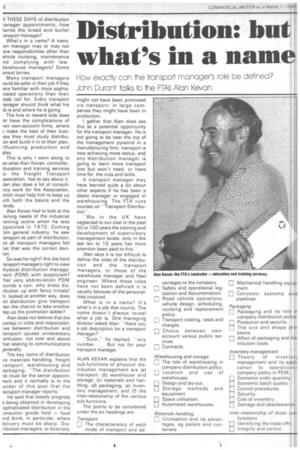Distribution: but what's in a name
Page 40

If you've noticed an error in this article please click here to report it so we can fix it.
How exactly can the transport manager's role John Durant talks to the ETAS Alan Kevan oe defined?
\I THESE DAYS of distribution -tanager appointments, .how tands the bread and butter -ansport manager?
What's in a name? A transort manager may or may not ave responsibilities other than ehicle routeing, maintenance nd complying with law. Siarehouse managers? Some ontrol lorries.
Many transport managers /Quid be safer in their job if they /ere familiar with more sophiscated operations than their osts call for. Ev6ry transport -onager should think what his )b is and where he is going.
The hire or reward side does ot have the complications of leir own-account firms, where ) make the best of their busiess they must study distribuon and build it in to their plan, Tfluencing production and ales.
This is why I went along to ee what Alan Kevan, controller, ducation and training services Dr the Freight Transport ,ssociation, has to say about it. Jan also does a lot of consultncy work for the Association, /hich must help him to keep up iith both the basics and the -ends.
Alan Kevan had to look at the -aining needs of the industrial raining scene when he was ppointed in 1970. Coming rom general industry, he saw 'ansport as part of distribution; ot all transport managers felt lat that was the correct deciion.
So was he right? Are die-hard 'ansport managers right to view ihysical distribution manage. lent (PDM) with scepticism? 'hat very abbreviation PDM ounds a con; why dress disribution up with fancy initials? )r, looked at another way, does lot distribution give transport len the chance to take another top up the promotion ladder?
Alan does not believe that the iverlap in titles and responsibilaes between distribution and ransport causes unnecessary :onfusion; not over and above hat relating to communications Jenerally.
The key items of distribution ire materials handling, freight ransport, warehousing and iackaging. "The distribution ab must be the senior appointnent and it normally is to the 'older of this post that the ransport manager reports."
He said that steady progress s being obtained in developing ;ophisticated distribution in the ;onsurner goods field — food ind drink, in particular, where lelivery must be sharp. Disribution managers, or directors, might not have been promoted via transport; in large cornpanics they might have been in production.
I gather that Alan does see this as a potential opportunity for the transport manager. He is not going to be near the top of the management pyramid in a manufacturing firm, transport is now achieving more status, and any distribution manager is going to learn more transport lore but won't need, or have time for, the nuts and bolts.
A transport manager may have learned quite a bit about other aspects if he has been a depot manager or engaged in warehousing. The FTA runs courses on "'Transport Distribution".
—We in the UK have neglected to our cost in the past 50 or 100 years the training and development of supervisory management levels; only in the last ten to 15 years has more attention been paid to this."
Alan says it is not difficult to define the roles of the distribution and the transport managers, or those of the warehouse manager and fleet engineer. Where these roles have not been defined it is usually because of the personalities involved.
What is in a name? It's what's in a job that counts. The name doesn't always reveal what a job is. One managing director asked Alan: "Have you a job description for a transport manager?"
"Sure," he replied, "any number . . . But not for your transport manager."'
ALAN KEVAN explains that the sub-functions of physical distribution management are (a) transport; .(6) warehouse and storage; (c) materials and handling; (d) packaging; (e) inventory management; and (f) the inter-relationship of the various sub-functions.
The points to be considered under the six headings are: Transport
E The characteristics of each mode of transport and ad
vantages to the company. E Safety and operational legislation.and documentation.
E Road vehicle operations: vehicle design, scheduling, routeing and replacement policy.
E Transport costing, rates and charges.
El Choice between ownaccount versus public services.
7 Contracts.
Warehousing and storage E The role of warehousing in company distribution policy. El Location and use of warehouses, O Design and lay-out.
0 Storage methods and equipment.
O Space utilisation. E Automated warehouses.
Materials handling E Unitisation and its advantages, eg pallets and containers. E Mechanical ment. handling equip
E Conveyor systems and pipelines.
Packaging E Packaging and its role ir company distribution policy E Protection and security. E The size and shape pro• blems.
Ej Affect of packaging and dis tribution costs.
Inventory management E Theory of inventor) management and its appli cation to operations/ company policy in PDM.
E Economic order quantity.
E Economic batch quality. E Control procedures. E Security. E Cost of inventory.
El Damage and obsolescenc
Inter-relationship of these $r functions
El Identifying the trade-offs. E Integrity and control.
















































































































